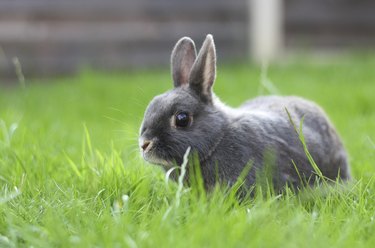
Because of their ease of growing and high nutritional value, beans make their way into vegetable gardens across the country. Most vegetable garden beans belong to the genus Phaseolus, incuding green and wax beans (Phaseolus vulgaris) and lima beans (Phaseolus lunatus). Gardeners also plant species from Vicia, Vigna and Cicer. Several pests feast on beans, including rabbits, deer and insects.
Damage Caused
Video of the Day
Although rabbits will eat numerous plants in the garden and landscape, they particularly enjoy beans, peas (Pisum sativum) and carrots (Daucus carota). Their sharp incisors most often leave a near-perfect, 45-degree angled cut in the stem. Rabbits feed on beans throughout the growing season. Because they prefer beans over many other plants, homeowners must take care to keep bean plants safe from these small mammals.
Video of the Day
Garden Fencing
Placing a fence around your garden will always be the most effective way of keeping your beans and other plants safe from rabbits. If cottontail rabbits are your only concern, an 18- to 24-inch fence will do the trick. If jackrabbits find their way into your garden -- which doesn't happen as frequently as with cottontails -- your garden fence should be 3 feet tall.
Place metal garden stakes every 4 or so feet around your bean plot; hammer them into the ground beyond the garden for security. Attach 1-inch mesh wire or poultry wire to the stakes with cable ties or other fasteners -- most metal garden stakes come with small hooks to attach fencing. Ensure the fencing is attached to the stakes at ground level as well and pulled taut; rabbits will try to push through the bottom. While 1-inch holes may seem unnecessary, these smaller holes will keep baby rabbits out of the garden.
Taste Repellents
Several repellents line the shelves of hardware and general-purpose stores, including taste and smell deterrents. Common ingredients in commercially available repellents include harsh chemicals and natural ingredients, including garlic, eggs and capsaicin.
Make your own by boiling one chopped onion, one chopped jalapeno and 1 tablespoon cayenne pepper in 2 quarts of water for 20 minutes. Allow to cool and strain the mixture through cheesecloth. Place in a spray bottle and spray your bean plants every three to five days and after it rains. The capsaicin -- the chemical that makes hot peppers burn skin and tongue -- effectively serves as a taste repellent. Use caution when mixing and spraying this mixture; the capsaicin can burn your eyes and skin, so wear gloves and eye protection.
Modifying the Habitat
Rabbits have distinct preferences in habitat. Cottontails prefer brush areas for daytime hiding, including thorny patches, thick-growing shrubs and piles of brush and debris. Nearby these thick hiding areas needs to be a source of food; your garden provides a buffet. Removing thick brush and other hiding areas from your yard may encourage rabbits to find refuge elsewhere.
Scare Tactics
As prey animals, rabbits have a strong reaction to the presence of predators in their areas. Hawks, foxes, coyotes and owls all prey upon rabbits, as do domestic cats and dogs. Keeping local predators in the area can help keep rabbits at bay. If you have four-legged companions, train them to do their business near your bean plot. Many commercially available repellents use predator urine as the active ingredient, typically fox or coyote urine in granulated formulas.
Letting your pooch have free roam around your beans can also help scare rabbits away from eating your bean plants.
- Purdue University Cooperative Extension Horticulture: Growing Beans in the Home Vegetable Garden
- University of Wisconsin-Extension: The Learning Store: Protecting Gardens and Landscape Plantings From Rabbits
- University of Nebraska-Lincoln Extension, Institute of Agriculture and Natural Resources: Prevention and Control of Rabbit Damage
- Mother Nature Network: How to Keep Squirrels Out of Your Attic
- University of Illinois Extension: Plants Not Favored by Deer and Rabbits
- New Mexico State University Cooperative Extension Service: Rabbits and Their Control in New Mexico
- Penn State Extension: Cottontail Rabbits